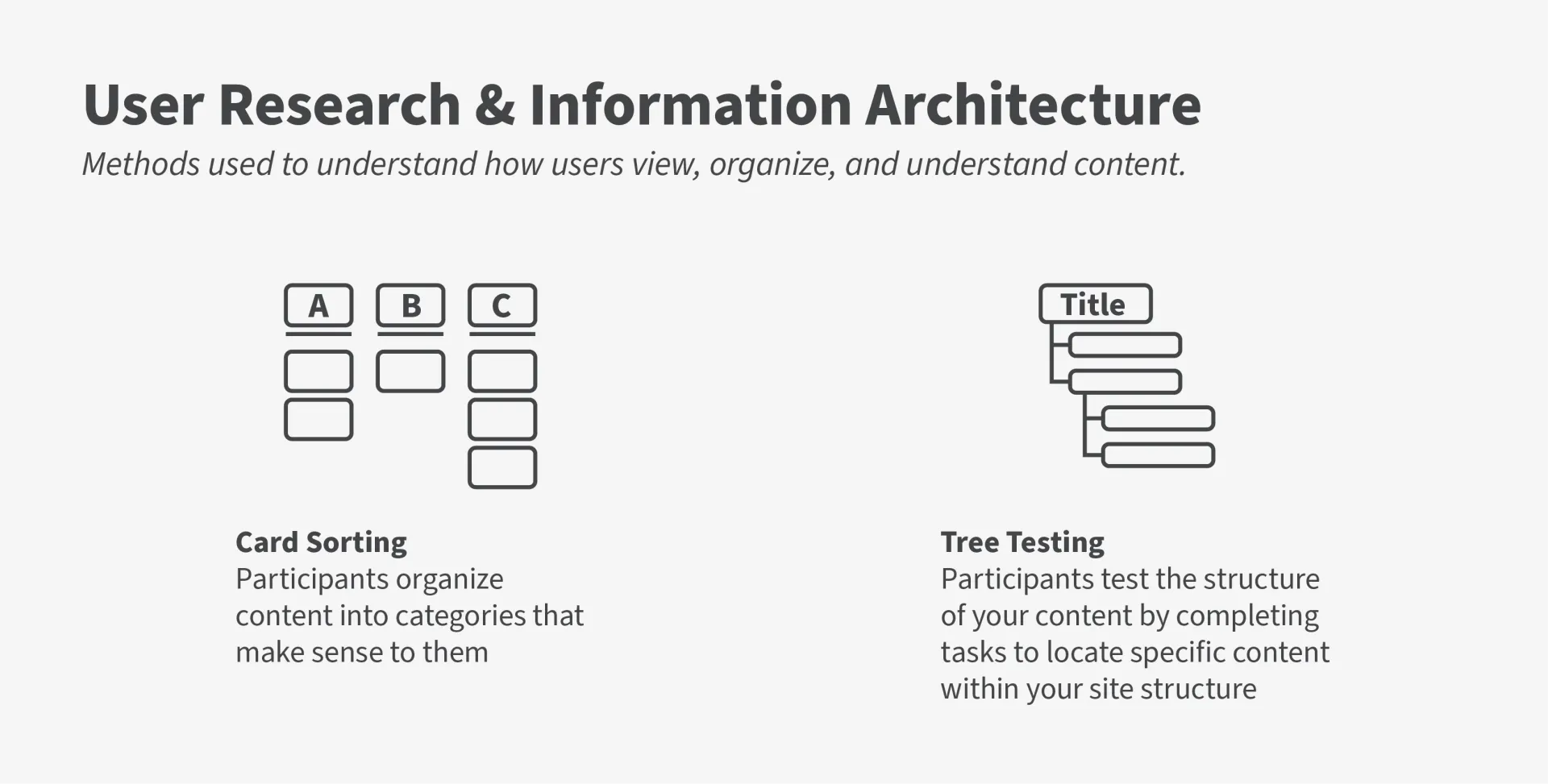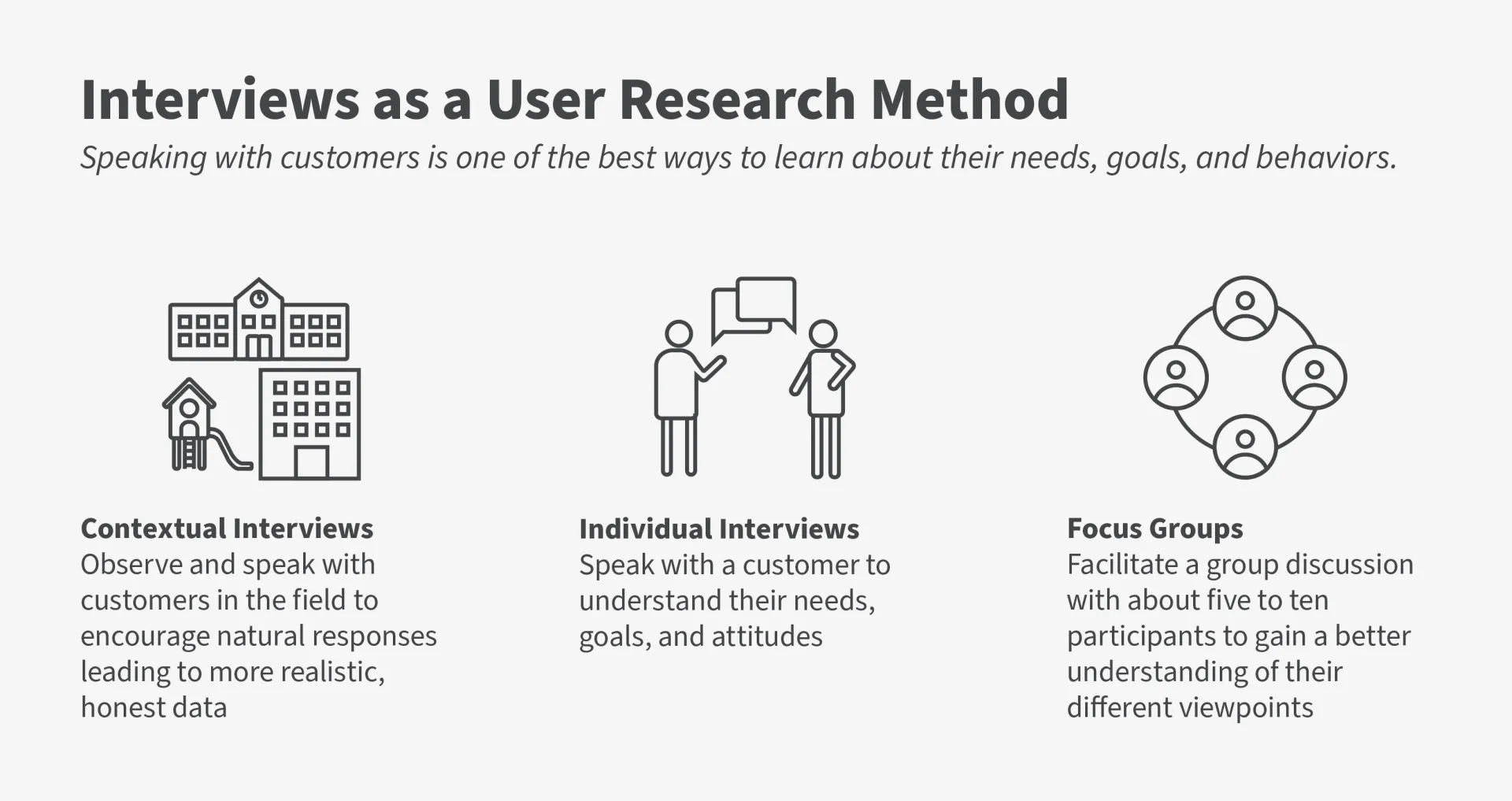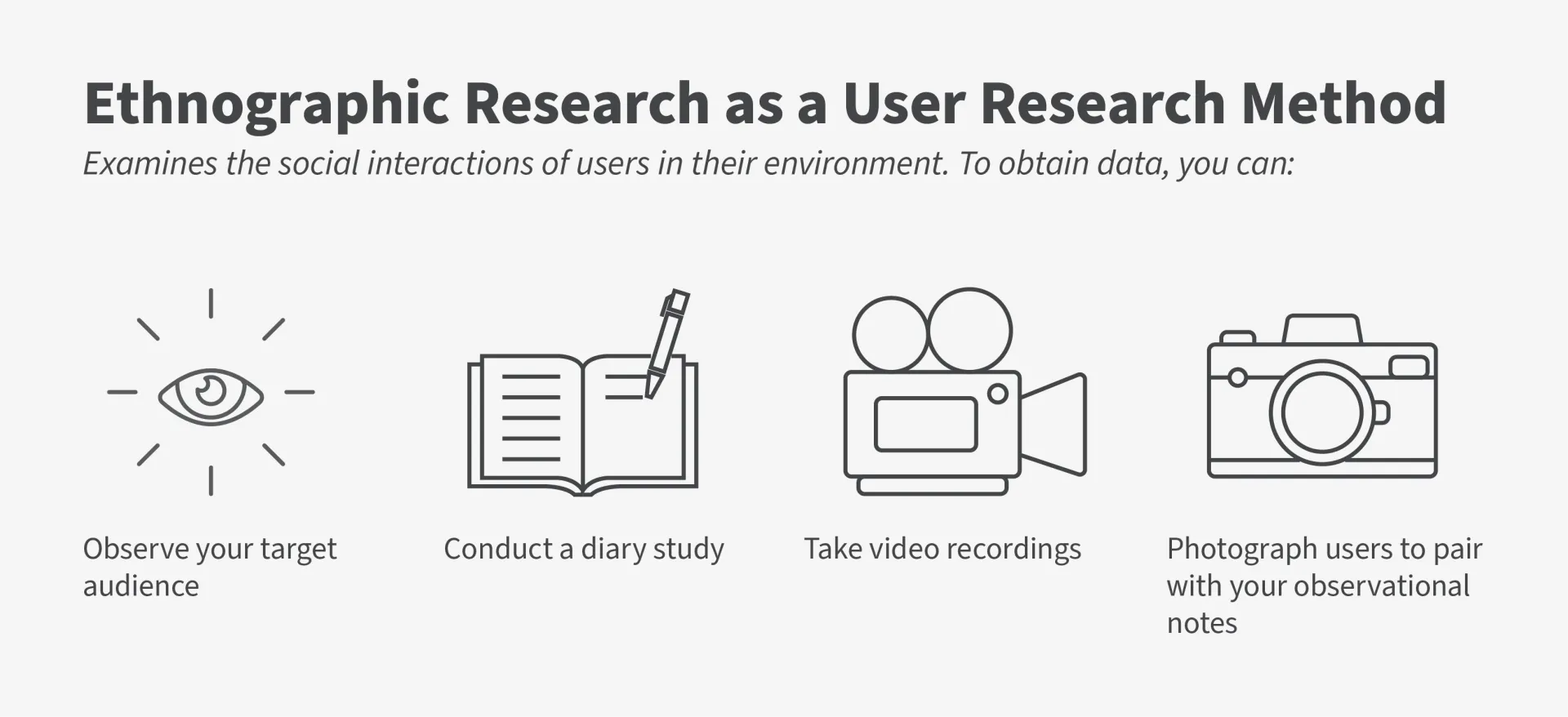Basics of User Research Lesson | 20 Minutes
Lesson Objective
- Understand common user research methods related to information architecture
- Understand how surveys are used
- Understand how interviews are used
- Understand how ethnographic research is used
- Understand how usability testing is used
Conducting user research is essential for creating a customer-centric organization. The method you choose to use depends on your research goals, budget, time frame, available resources, and what kind of data you need.
Let’s explore some common methods for conducting user research.
User Research & Information Architecture
Information architecture (IA) focuses on the way content is organized, structured, and labeled to communicate information clearly and effectively to your users. Your information architecture should provide your users a pathway that is easy to understand and follow so they can find the information they are looking for.
If you’d like to understand how users view, organize, and understand content, there are two common methods to evaluate information architecture:
Card Sorting: Participants organize content into categories that make sense to them. You can conduct card sorting activities physically, with pieces of paper, or digitally with an online card sorting tool. Card sorting helps you understand your users’ expectations and understanding of your content.
Example: You ask participants to take ten individual articles and sort them into two predefined groups. This is known as a closed card sort. Alternatively, you could ask participants to create their own categories and sort the ten articles into these categories. This is known as an open card sort. These methods are not rigid, a combination of both can be used.
Tree Testing: Participants test the structure of your content by completing tasks to locate specific content within your site structure. Tree testing helps you understand if content is structured and labeled in a way that makes sense to your users. It is often used in concert with card sorting. Once your categories have been defined, tree testing can justify the decisions made during the card sorting activity.
Example: You ask participants to use web navigation to select where they might find an intake form. You could also use something like a table of contents (non-digital) to see where participants think they might find the intake form.
For both methods, the data you receive is considered ‘thin data.’ Unlike ‘thick data,’ thin data doesn’t provide context for participants’ responses – it can’t tell you why participants made the selections they did. Instead, it collects participants' responses to create a more customer-centric service/product.
Surveys as a User Research Method
Surveys are structured questionnaires that your target audience can answer through a selection response, short answer response, or extended answer response. Surveys can be completed on paper, digitally, and/or verbally over the phone. The length and format of your survey will vary depending on the feedback you are looking to receive.
The data you gather from surveys will likely be thin data. Most surveys collect responses without digging deeper into the reasoning behind a participant's selection – they are one-way conversations. If your survey asks participants to explain their answers, they may not fully explain themselves to qualify their response as thick data.
Interviews as a User Research Method
Speaking with customers is one of the best ways to learn about their needs, goals, and behaviors. Depending on your research goals, you may want to conduct specific kinds of interviews.
There are three common user interview methods:
Contextual Interviews: Observe and speak with customers in the field. By conducting these types of interviews, you encourage natural responses leading to more realistic, honest data. During interviews, you can gather thick and thin data depending on your interview questions. Thick data will come from probing questions that will ask the interviewee to explain and support their responses with more information.
You may visit a park, community center, and/or a location where the user uses your service/product to conduct contextual interviews. Contextual interviews should be separated into two parts with the interview and the observations being completed during separate sessions to gain a full understanding of the participants’ knowledge and ability to use your service/product.
Individual Interviews: Speak with customers to understand their needs, goals, and attitudes. Interviews can range in duration – most are typically 30-60 minutes long. You can gather thick and thin data during interviews, depending on the types of questions you ask. Thin data will reflect a participant's responses without supporting information. Thick data can include supporting information such as explanations, context and the significance behind the participant’s opinion, viewpoint, and/or response.
You can conduct individual interviews in-person, over the phone, and/or virtually through a video conference. Interviews should be conducted in an environment that is welcoming to the participant and free of distractions. The key to successful interviewing is to make your participant feel comfortable – they’ll provide secure with their responses.
Focus Groups: Facilitate a group discussion with about five to ten participants to gain a better understanding of how different users view your organization and its services. During the discussion, a moderator guides participants with questions to keep the conversation productive and the participants on task. With this method, you often receive thin data because of the group dynamic. Individual responses may be impacted by groupthink, where all participants come to a common answer, and not hold the significance and/or background of thick data.
You can conduct focus groups in-person and/or virtually through a video conference. Focus groups can be both challenging and extremely rewarding depending on the group's familiarity and how comfortable they feel sharing their honest responses in front of each other. An experienced moderator can improve the results – if you make the group feel welcomed and keep them focused, you can gather useful feedback during the session.
Ethnographic Research as a User Research Method
Ethnographic research examines the social interactions of users in their environment. This type of research provides you with a deeper understanding of a day-in-the-life of your users. To obtain data, you can observe your target audience, conduct a diary study, take video recordings, and/or photographs to pair with your observational notes.
The information you gather can be thick or thin depending on the length of your study and where it is conducted. If you conduct a month-long study in a neighborhood, you may gain deep knowledge and understand your target audience’s behavior and motivations by observing them in their living situation, which would be considered thick data. However, if you complete a short workplace study, you may gather thin data that doesn’t provide a deep understanding of the target audience’s behavior because of the short duration and limited location.
Usability Testing as a User Research Method
Usability testing is used to learn how easy or difficult it is for people to use a service or product by watching them complete “real life” tasks. The goal is to identify users’ pain points and create human-centered solutions that are easy to use. You can conduct usability testing throughout the service and/or product lifecycle. This method can include qualitative and quantitative feedback.
The data you gather can be thick or thin depending on the types of questions you ask. To gain thick data, you need to probe and ask follow-up questions. Thin data would reflect straightforward participant responses without following up to learn more about the reasoning behind the response.
In Summary
The purpose of user research is to better understand your users' needs, goals, and behaviors. There are multiple methods to choose from. No matter which method you choose, deciding to actively learn from and about your users brings you and your organization closer to providing more human-centered services and products.
Resources
Article:
Using the Tools You Have to Conduct Card Sorting and Tree Testing (Digital.gov)
Focus Groups: Are They Right for You?
User Acceptance Testing Versus Usability Testing... What's the Dif? (Digital.gov)
Web Resource:
Information Architecture Basics (Usability.gov)
User Research Basics (Usability.gov)
Download:
Customer Experience Center of Excellence Playbook (GSA)
Video:
An overview of the DHS Usability Testing Kit (Digital.gov)
Survey Translation & the Inclusion of End Users in the Process: Experiences from... (Digital.gov)



